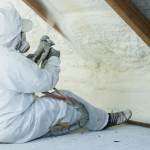Here’s a little-known fact: the time to reduce winter heating bills doesn’t start in winter! To reduce your heating bills, you need to prepare before winter starts. Follow the tips below and drastically reduce your heating bills this winter!
Air Leaks and Heat Loss
Seal all gaps to prevent air leaks and heat loss. Gaps, cracks, and small openings are present in doors, windows, electrical outlets, light switches, and lighting fixtures. Install foam gaskets or plastic security caps for outlets and switches. Sealing small openings will prevent heat from escaping through those gaps and will reduce heating costs.
Windows
If a house has single-pane windows, replace these with energy-efficient double-pane windows with intert argon gas fill, warm-edge spacers and low-e coating, or add storm windows to cut heat loss by up to 50%.
As preparation for winter, remove window air-conditioners or, if they can’t or shouldn’t be removed, use caulking or tape to seal them and make sure they are covered with an airtight, insulated jacket.
Heating System
Chimneys and vent systems should be clear and unobstructed. Clean the chimney and heating vents and have the vent systems checked. Make sure to check that pipes are properly connected and there aren’t any indications of damage or rust. Check that heating vents are free from obstructions such furniture and drapes and that the dampers are open.
If the replacement of the furnace is an option, choose a furnace that has an efficiency rating of 90% or higher. A new, more energy efficient furnace can save up to 30% of heating costs over the old ones. Make sure that there is an ENERGY STAR® label.
Insulation
The insulation in the attic, basement, exterior walls, and crawlspaces can be upgraded for a minimal cost. Insulation comes in batts or loose fill, which can be blown into place and fill hard to reach areas.
Water
If the surface of a water heater is hot or even warm, this indicates that some of the energy used to heat water is being wasted. Wrapping the heater in an insulating blanket will prevent the loss of heat.
The constant availability of hot water may indicate that the hot water thermostat may be set too high. Set the hot water thermostat between 43 and 49 degrees Celsius before winter arrives.
More heat is lost as it moves through longer pipes. The closer rooms are to the water heater, the less need for longer pipes, the less heat lost, the more energy and money saved. Place the water heater as close as possible to kitchen, laundry room, and bathrooms when constructing a new house.
The Ultimate Way to Cut Your Winter Energy Bill
Do-it-yourself energy generation is all the rage these days. If you’re a do-it-yourselfer, you should seriously consider investing in an inexpensive guide to show you how to start generating your own solar power.
Here are two popular options:
Green DIY Energy (recommended)






Leave a Reply